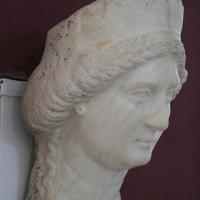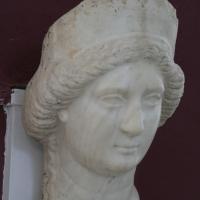Female head by the sculptor Antiochus
Inscription
Ἀντίοχος Δρύαντος
ἐποίει.
Antiochus, son of Dryas,
made [this].
Comment
The inscribed marble head was excavated at the sector of the 'Isthmus' (location map, Martinez-Sève 2002: 46), near the 'Donjon' where the majority of the Greek inscriptions from Susa have been found. In this general area could be located the important Susian sanctuary of the Elymaean goddess Nanaia (Cumont 1931: 278-279; Martinez-Sève 2002: 49 with n. 76) or the administrative center of the hellenistic, and subsequently Parthian, city of Susa (Boucharlat 1985: 75-76).
The sculpture was first published by Franz Cumont (1939 with pls. I-II; see also de Mecquenem and Conteneau 1943: 69, pl. IX; Colledge 1979: 225-226; idem 1990). A brief Greek inscription, carved in two symmetrical lines on the crown above the face, identifies the artist, who was responsible for this work, by his Greek name, 'Antiochus', and equally Greek patronymic, 'son of Dryas' (Cumont 1939: 334-336, fig. 1; Canali De Rossi 2004: no. 215; Merkelbach and Stauber 2005: no. 401; Rougemont 2012: no. 30). A large circular dowel hole beneath the neck could imply that the head was sculpted separately from the body on which it was affixed. In this case the unusual placement of Antiochus' signature on the crown could imply that only the head of the composite image was carved by this sculptor (Cumont 1939: 331; but see Amiet 2001: 249, for the suggestion that the head might be meant to be affixed on a wall, as a masque).
Sculptural style and technique, as well as the forms of the letters of the inscription are held to place the execution of this piece sometime between 100 BC and the mid-first century AD, thus 'during the time when Susa retained its character as a Greek city under Parthian rule' (cf. Rougemont 2012: 76).
Opinion is divided concerning the identity of the represented female. According to some scholars, she could be the goddess Tyche, 'Fortune', as protectress of the city (e.g., Colledge 1977: pl. 9c; idem 1979: 225; idem 1990; Amiet 2001: 249). In the view of others, the head is most likely a portrait of the consort, Musa, of the Parthian king Phraates IV (ca. 37-2 BC) or some other Parthian queen (e.g., Cumont 1939: 337-339; Kawami 1987: 53-56; Parlasca 2002; P. Bernard apud Rougemont 2012: 76). In the latter case, the sculpture would constitute an instance of Arsacid Parthian royal art.
The deviation of the piece from the norms of contemporary Greco-Roman sculpture is evidenced especially by the Achaemenid (as well as earlier Assyrian) type of stepped merlon depicted on the mural crown. This suggests a probable origin of the sculpture from a workshop in Asia (e.g., Colledge 1979: 226; Kawami 1987: 53-54, with reference to 'distinctly Iranian' associations of the crenelated crown; Amiet 2001: 244-245, ascribing the head to a 'greco-oriental "Parthian"' series of Susian sculpture).
The possibility that the head was made in a local Susian workshop emerges from the signature formula, which identifies the otherwise unknown sculptor of the head by his name and patronymic but does not record his ethnic. The absence of the ethnic would tend to imply that Antiochus was a citizen of Susa (Le Rider 1965: 272 n. 8, 414).
The find testifies for the ongoing dialogue between Iranian and Greek artistic trends and iconographic predilections, as well as for the continuing use of the Greek language at Susa under the Parthian regime down to the end of the first millennium BC or the beginning of the first millennium AD.
Bibliography
Amiet, P. 2001. 'La sculpture susienne à l'époque de l'empire parthe.' Iranica antiqua 36: 239-291.
Boucharlat, R. 1985. 'Suse, marché agricole ou relais du grand commerce. Suse et la Susiane à l'époque des grands empires.' Paléorient 11: 71-81.
Canali De Rossi, F. 2004. Iscrizioni dello estremo oriente greco. Un repertorio. Inschriften griechischer Städte aus Kleinasien 65. Bonn.
Colledge, M. A. R. 1979. 'Sculptors' stone-carving techniques in Seleucid and Parthian Iran, and their place in the "Parthian" cultural milieu: some preliminary observations.' East and West 29: 221-240.
——. 1977. Parthian Art. London.
——. 1990. 'Musa from Susa, or, Tyche revealed.' Études et travaux: Studia i prace 15 [Travaux du Centre d'archéologie méditerranéenne de l'Académie des sciences polonaise 30]: 99-108.
Cumont, F. 1931. 'Inscriptions grecques trouvées à Suse.' Comptes rendus des séances de l'Académie des Inscriptions et Belles-Lettres: 278-292.
——. 1939. 'Portrait d'une reine parthe trouvé à Suse.' Comptes rendus des séances de l'Académie des Inscriptions et Belles-Lettres: 330-341.
Kawami, T. S. 1987. Monumental Art of the Parthian Period in Iran. Acta Iranica 26. Leiden.
Le Rider, G. 1965. Suse sous les Séleucides et les Parthes. Les trouvailles monétaires et l'histoire de la ville. Mémoires de la Mission archéologique en Iran XXXVIII. Paris.
Martinez-Sève, L. 2002. 'La ville de Suse à l'époque hellénistique.' Revue archéologique 33: 31-54.
de Mecquenem, R. and Conteneau, G. (eds.) 1943. Archéologie susienne. Mémoires de la Mission Archéologique de Perse XXIX. Paris.
Merkelbach, R. and Stauber, J. 2005. Jenseits des Euphrat. Munich and Leipzig.
Parlasca, K. 2002. 'Das Bildnis einer parthischen Königin („Musa").' Archäologisches Korrespondenzblatt (Römisch-Germanisches Zentralmuseum) 32.3: 407-414.
Rougemont, G. 2012. Inscriptions grecques d'Iran et d'Asie centrale, avec des contributions de Paul Bernard. Corpus Inscriptionum Iranicarum, part II, vol. I.1. London.
Cite this entry:
Zournatzi, A. 2016. 'Šuš (Susa): Female head by the sculptor Antiochus.' In Mapping Ancient Cultural Encounters: Greeks in Iran ca. 550 BC - ca. AD 650. Online edition, preliminary draft release. Available at http://iranohellenica.eie.gr/content/catalogue/sus-susa/documents/1636387182





Female head of white marble by the sculptor Antiochus. Mound of the 'Ville Royale' (Area 'Isthme'). Šuš (Susa), Ḵūzestān province, Iran. Ca. 100 BC - ca. AD 45. Excavations of R. de Mecquenem (Mission archéologique de Susiane), 1939. National Museum of Iran, no. 2452. H. 0.375 m, W. 0.24 m.